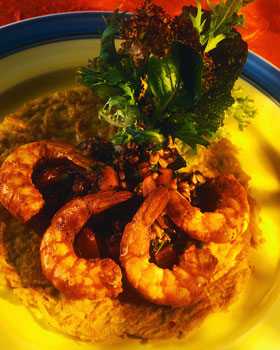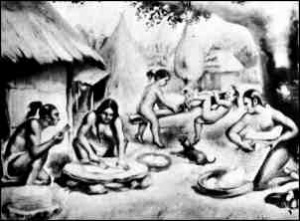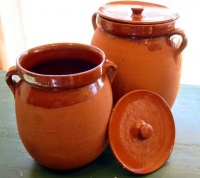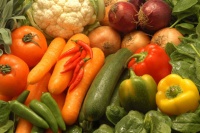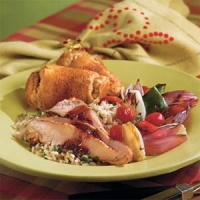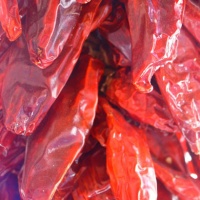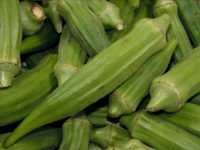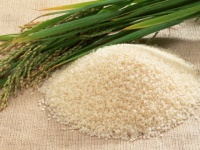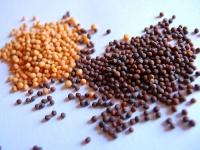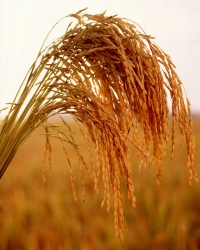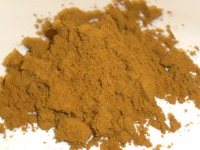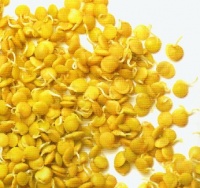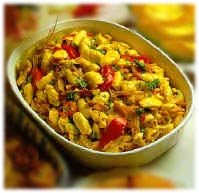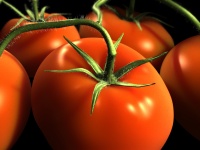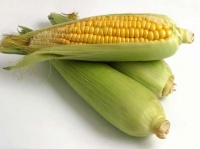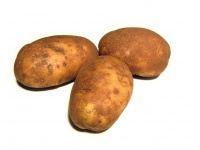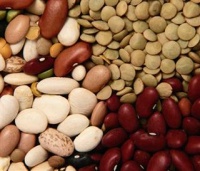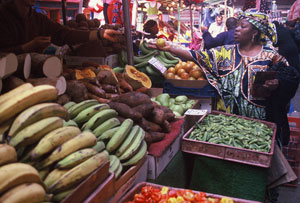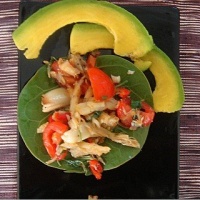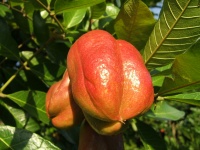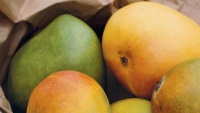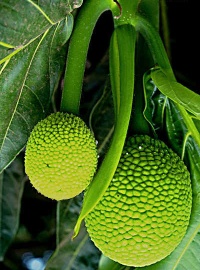Food
From Seminar 2: The Peopling of New York City
Contents |
Overview
The West Indian area of Flatbush is rich with culture and diversity. It has various ways of expressing distinct traditions and practices. Food is one major way that West Indians can retain their history. It allows them to connect deeply with their homeland, even though some are second and third generation immigrants. It helps us to understand the way that West Indians view themselves, as individual countries and also as a whole. Each individual has pride in their own ethnic foods, and it helps us to understand the reasons behind nationalistic pride. Even though the West Indians retain their ethic foods, some foods have blended into the everyday American diet. The study of West Indian food allows us also to understand the influence of West Indian culture on the American diet, and also the American influence on West Indian food, especially in the area of Flatbush.History
To understand the food today, we have to understand history of the Islands. The Carib, Taino and Arawak Indians were the first residents of the West Indies. Their diets mostly consisted of a variety fruits and vegetables. They started the long tradition of cooking in clay pots. The long-standing tradition of eating hot foods originated from the Carib Indians who put peppers into their stews. But since there were no methods of recording recipes, they did not pass down the exact recipes to the later generations.
African Influences
However, most of the foreign influence came from the colonization of the West Indies by the British and Europe. The British brought slaves from Africa in the triangular trade. These African slaves left an enormous impact on West Indian food. Since the slaves were not able to eat the food of the masters they were left with the scraps that they were provided by the masters, which usually consisted of leftovers and various rotten foods. The slaves had to become more creative in their limited types of foods, so they created an assortment of mixed foods that are still eaten today. Africans introduced ackee, callaloo, okra and various other staples. Africans introduced an important type of food called “jerk.” The African hunters used to cook meat over the coals in order to preserve it for a long period of time they were away from home. This influence can be seen especially in Jamaica where “jerk” meat is almost a staple.Asian Influences
The next major influences on West Indian cusines came from Asia, largely from India and China. After slavery was abolished, the Europeans have to seek elsewhere for labor replacement. The immigration of Chinese and Indians influenced West Indian foods. These distinct tastes from each region can be clearly seen though South Indian-West Indian foods and Chinese-Caribbean foods.China
The Chinese were also brought to the West Indies as indentured slaves to fill in the void of newly-freed African slaves. They introduced rice to the West Indies. On the other hand, India introduced it mainly to Trinidad and Guyana. China also introduced mustard, which is used in Chinese-Caribbean cooking. Typical Chinese-Caribbean dishes include:Bangamary Ding (nuts and vegetables mixed with fried fish), Cha Chee Kai (deep-fried chicken a special sauce), Jerk Chow Mein (jerk meat with vegetables and egg noodles), curried duck with roti (potatoes and duck meat drenched in curry rolled in a tortilla-like bread), Char Sui Pork Dhalpouri (cumin, onions, pork, and peas rolled in a roti).
India
Most of the foods brought over by the Indians were religious foods; they basically were raw food that were uncooked because according to Hindu traditions, cooked food was contaminated. Since the Indians that came to the Caribbean were mainly indentured servants, they could not afford to eat the same things that they ate in India. They were forced to change their diets to less costly items, such as native Caribbean staples. Since the Indian diet consisted of mainly of rice, Indians were skilled at rice cultivation. Indians like the Chinese helped introduce rice in Trinidad and Guyana. Indians also introduced curry and lentil.Portuguese Influences
The Portuguese also had a major influence on food in the West Indies. They introduced codfish. This is the main ingredient callaloo soup (in some islands). The Portuguese influence is also seen in the use of alcohol in cooking meat. Initially, alcohol was a Mediterranean flavor. The influences of this mix can be seen through this style of using alcohol in cooking. Africans used to use rum to tenderize meat, but the Portuguese used red wine in order to marinate their meat. West Indians however use both of their methods, by incorporating alcohol during the preparation of the meat as well as the actual cooking of the meat.American Influences
The Americas has also influenced West Indian food. They introduced types of vegetables that were not native to the Caribbean. The vegetables included corn, beans, squash, tomatoes, and potatoes. And it also involved the trade of sugar and coffee produced in Barbados and Jamaica. America food has been greatly influenced by West Indian chefs. For example, coconut shrimp is sometimes referred to as “staple on the menu of the New York’s Four Seasons.” “Plantains, jicama, yuca, batata, yautia, chayote and the like have been around for years, accessible to chefs in any city with a Puerto Rican or Mexican population.” These foods have somewhat integrated with the American menus, and the restaurants do not necessarily have to be West Indian. These items are available in many supermarkets where there are consumers from Latin America and the Caribbean, but these foods are still rarely eaten by non-Latin Americans and Caribbeans.
The Market
All these influences have helped to shape the West Indian diet in Flatbush. When a person walks around the area of Flatbush, they will encounter ethnic foods and ethnic markets. Each ethnic market helps to enhance the diversity of the neighborhood. In the markets one will encounter fruits and vegetables that cannot be found in typical supermarkets in New York. There is an excitement and connection that is created between the shop owners and the consumers. When buying ethnic food, often the customer will change their dialect to a more ethnic accent or start speaking Creole. This helps the individual connect with their neighborhood. The foods that are found in a typical market in Flatbush:
Identity
“West Indians justified friendship with other West Indians by invoking a cultural imperative that focused on group relationships and cultural symbols that bring people together, such as food, music, and historical experiences.” This quote is saying that West Indians are able to relate to other West Indians through ethic connections in food and music. And this connection might happen publicly in a market or privately in the kitchen. But the overall connection is the ingredients that are used. Every individual person has their own way of preparing dishes but the overall recipe is always the same. When something like “ackee” or “rice and peas” is mentioned, West Indians are almost always able to figure out what they are, what they look like, and even what they taste like.
With food comes the nationalistic pride that each country has. Even though the overall cooking and style of cooking might be the same, each country varies in main dishes, and similar dishes are prepared in different ways in different countries. They might all fall under the West Indian category but they do have dishes that they specialize in. For example, one person that was interviewed at Seseme Flyers is an immigrant from Trinidad. He was asked about his feelings toward ackee, he replied “To me it'as tasteless. But I would not say that in front of a Jamaican.” But when asked about Trinidadian foods he becomes more open and comfortable to speak about it. He starts to mention foods that were common to Trinidad and the West Indies, but to him it seemed like there was a difference in the way that each country prepared it. He talks about Trinidadian food with a lot of pride. At one point in the interview he is talking about the way callaloo is prepared and says, “It tastes good. It tastes very good.” He might have not said that if it was not a traditional Trinidadian food. After asked if he was just saying that because he was Trinidadian and he replies “I have been eating it all my life. It better be good.”
Although if individually asked most West Indians, they will say that there is a difference between the different countries and the foods that they make, but according to the menus that are provided by the restaurants in the area of Flatbush there is not much of a difference. Comparing two menus one from Trinidadian restaurant and another from a Jamaican restaurant, it is safe to assume that they are more alike than different. They both contain items such as cow foot and saltfish. But the most important difference between the two menus is that the Jamaican restaurant has “jerk” items unlike the other Trinidadian restaurant.
The similarities and the differences that are shown in the area of Flatbush help us to understand the diversity and the separation between the people of this West Indian area.
Works Cited
Thompkins, Linda. "Caribbean Food - A Little History." EzineArticles 23 June 2005. 16 April 2008 <http://ezinearticles.com/?Caribbean-Food---A-Little-History&id=45781>.
Cook, Ian, and Michelle Harrison. "Crossover Over Food: Re-Materializing Postcolonial Geographies." Transactions in the Institute of British Geographers 28 (2003): 296-317. Academic Search Premier. 21 Mar. 2008.
Kiple, Kenneth F., and Kriemhild C. Ornelas. Cambridge World History of Food. Vol. II. Cambridge: Cambridge UP, 2000.
Houston, Lynn M. The Food Culture in the Caribbean. Westport: Greenwood Press, 2005.
Fabricant, Florence. "American Chefs 'Under the Influence' of Caribbean - Currents in Cuisine." Nation's Restaurant News 20 May 1991. 17 Apr. 2008 <http://findarticles.com/p/articles/mi_m3190/is_n20_v25/ai_10747564>.
Sharma, S, and J K. Cruickshank. "Cultural Differences in Assessing Dietary Intake and Providing Relevant Dietary Information to British African - Caribbean Populations." Journal of Human Nutrition and Dietetics 14 (2001): 449-456. Academic Search Premier. 21 Mar. 2008.
McEwen, Cecil. Personal interview. 05 Apr. 2008.
Jackson, Jennifer V., and Mary E. Cothran. "Black Versus Black: the Relationships Among American, African American, and African Caribbean Persons." Journal of Black Studies 33 (2003): 576-604. Academic Search Premier. 18 Apr. 2008.
Olien, Michael D. "After the Indian Slave Trade: Cross-Cultural Trade in the Western Caribbean Rimland, 1816-1820." Journal of Anthropological Research 44 (1988): 41-66. JSTOR. 18 Apr. 2008.
http://images.google.com/imgres?imgurl=http://www.radiojamaica.com/images/stories /caricom_flags_sm.jpg&imgrefurl=http://www.radiojamaica.com/content/view/3710/88/& h=250&w=222&sz=45&hl=en&start=28&um=1&tbnid=QnAJEb_jWjyvvM:&tbnh=111&tbnw=99&prev=/ images%3Fq%3Dcaribbean%2Bflags%26start%3D20%26ndsp%3D20%26um%3D1%26hl%3Den%26sa%3DN
http://images.google.com/imgres?imgurl=http://www.texascaribbeanfoods.net/image/ 4382153.jpeg&imgrefurl=http://www.texascaribbeanfoods.net/&h=350&w=280&sz=38&hl =en&start=5&um=1&tbnid=ggwFltUad1Yk1M:&tbnh=120&tbnw=96&prev=/images%3Fq%3Dcaribbean %2Bfood%26um%3D1%26hl%3Den%26sa%3DG
http://images.google.com/imgres?imgurl=http://www.historyofcuba.com/images/gallery /TLife-2.jpg&imgrefurl=http://www.historyofcuba.com/gallery/E-Gal-2.htm&h=222&w=302& sz=9&hl=en&start=58&um=1&tbnid=7fa-N8dY1sVDXM:&tbnh=85&tbnw=116&prev=/images%3Fq%3Dta inos%26start%3D40%26ndsp%3D20%26um%3D1%26hl%3Den%26sa%3DN
http://images.google.com/imgres?imgurl=http://www.ranchogordo.com/assets/images/co ok_claypots/clay_pots_-035.jpg&imgrefurl=http://www.ranchogordo.com/html/rg_cook_c laypots.htm&h=348&w=392&sz=18&hl=en&start=12&um=1&tbnid=84oXQsDlBfog1M:&tbnh=109&tbn w=123&prev=/images%3Fq%3Dclay%2Bpots%26um%3D1%26hl%3Den%26sa%3DG
http://images.google.com/imgres?imgurl=http://www.davidsonread.com/com mercial/images/vegetable_main.jpg&imgrefurl=http://www.clickfornick.com /&h=271&w=408&sz=39&hl=en&start=8&um=1&tbnid=V6e6e8VIMQMYlM:&tbnh=83&tbnw= 125&prev=/images%3Fq%3Dvegetables%26um%3D1%26hl%3Den%26sa%3DG
http://images.google.com/imgres?imgurl=http://i.timeinc.net/recipes/i/recipes /sl/05/08/jerk-turkey-sl-1084347-l.jpg&imgrefurl=http://find.myrecipes.com/recipes /recipefinder.dyn%3Faction%3DdisplayRecipe%26recipe_id%3D1084347&h=300&w=300&sz=25& hl=en&start=61&um=1&tbnid=l2wl6npTwssLHM:&tbnh=116&tbnw=116&prev=/images%3Fq%3Djerk %2Bmeat%26start%3D60%26ndsp%3D20%26um%3D1%26hl%3Den%26sa%3DN
http://images.google.com/imgres?imgurl=http://www.happynews.com/living/cooking/cover .jpg&imgrefurl=http://www.happynews.com/living/cooking/chili-peppers.htm&h=390&w=390 &sz=48&hl=en&start=56&um=1&tbnid=Fbdq_ESRpAie0M:&tbnh=123&tbnw=123&prev=/images%3Fq% 3Dchili%2Bpeppers%26start%3D40%26ndsp%3D20%26um%3D1%26hl%3Den%26sa%3DN
http://images.google.com/imgres?imgurl=http://www.seasonedpioneers.co.uk/assets/r ecipes/pile%2520of%2520fresh%2520picked%2520okra.jpg&imgrefurl=http://www.seasoned pioneers.co.uk/recipedetail.aspx%3Frid%3D34&h=375&w=500&sz=35&hl=en&start=3&um=1&tb nid=4_wKN-TWrlGiTM:&tbnh=98&tbnw=130&prev=/images%3Fq%3Dokra%26um%3D1%26hl%3Den%26sa%3DG
http://www.theagni.com/2006/12/india-and-china-were-they-ever-equal.html
http://images.google.com/imgres?imgurl=http://vbaines.files.wordpress.com/2007/08/china -flag2.jpg&imgrefurl=http://vbaines.wordpress.com/2007/08/&h=281&w=353&sz=19&hl=en&start =8&um=1&tbnid=IdUAv9LdyOw6WM:&tbnh=96&tbnw=121&prev=/images%3Fq%3Dchina%2Bflag%26um%3D1% 26hl%3Den%26sa%3DG
http://images.google.com/imgres?imgurl=http://keetsa.com/blog/wp-content/uploads/ 2007/10/rice.jpg&imgrefurl=http://keetsa.com/blog/category/world-map/africa/&h=330 &w=440&sz=59&hl=en&start=3&um=1&tbnid=_qrS8ETPjtfnQM:&tbnh=95&tbnw=127&prev=/images %3Fq%3Drice%26um%3D1%26hl%3Den%26sa%3DG
http://www.flickr.com/photos/wordridden/130162843/
http://www.istockphoto.com/file_closeup/object/4606227_flag_of_india.php?id=4606227
http://images.google.com/imgres?imgurl=http://www.resimao.org/images/product/12.1 1.30US_long_grain_rice.jpg&imgrefurl=http://wanderingchristing.wordpress.com/feed/ &h=801&w=640&sz=157&hl=en&start=12&um=1&tbnid=JcANQweVxffr4M:&tbnh=143&tbnw=114&prev =/images%3Fq%3Drice%26um%3D1%26hl%3Den%26sa%3DN
http://mathy.kandasamy.net/virundhu/archives/category/vegetarian/
http://images.google.com/imgres?imgurl=http://www.sproutnet.com/Lentil_Sprouts. jpg&imgrefurl=http://www.sproutnet.com/toc.htm&h=326&w=346&sz=35&hl=en&start=4&u m=1&tbnid=At3L6Ly3lJjgGM:&tbnh=113&tbnw=120&prev=/images%3Fq%3Dlentil%26um%3D1%26 hl%3Den%26sa%3DN
http://www.tiscali.co.uk/reference/encyclopaedia/countryfacts/portugal_flag.html
http://blog.getjamaica.com/2007/08/best-jamaican-ackee-and-saltfish-recipe.html
http://www.portuguesefood.com/acatalog/Salted_Codfisf__Whole_.html
http://aast.wordpress.com/2007/07/04/asian-americans-in-the-us-military/
http://www.blendernation.com/2007/05/04/subsurface-scattering-now-part-of- internal-renderer/
http://happyhomemaker88.wordpress.com/2007/11/08/dosanko-cooking-easy-nutritious -milk-corn-soup/
http://www.pachd.com/free-images/food-images.html
http://www.msnbc.msn.com/id/12483399/
http://commons.wikimedia.org/wiki/Image:Ackee_001.jpg
http://membres.lycos.fr/microzoo/aliments.html
http://www.abc.net.au/gardening/images/mangoes_m1541827.jpg
http://www.vanheygen.com/Silhouette/foilage.htm

